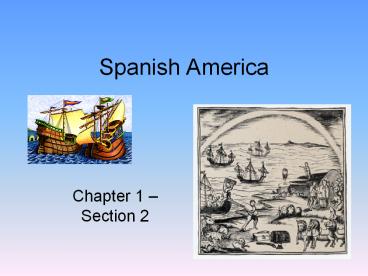Spanish America Chapter 1 Section 2 Impact of Columbus - PowerPoint PPT Presentation
1 / 17
Title:
Spanish America Chapter 1 Section 2 Impact of Columbus
Description:
Spanish America Chapter 1 Section 2 Impact of Columbus discovery When did Columbus set sail? Where did Columbus sail from? What were the names of the ships? – PowerPoint PPT presentation
Number of Views:68
Avg rating:3.0/5.0
Title: Spanish America Chapter 1 Section 2 Impact of Columbus
1
Spanish America
- Chapter 1 Section 2
2
Impact of Columbus discovery
- When did Columbus set sail?
- Where did Columbus sail from?
- What were the names of the ships?
- Why did Columbus set sail?
- Where was he going? Why?
- How did the journey go? Did he achieve what he
was wanting to achieve?
3
(No Transcript)
4
Impact on Native Americans
- Europeans were learning of the profitability of
the plantation system relying on what? - Economic benefit of using local forced labor
- Disease Europeans, unknowingly brought
measles, mumps, chickenpox, smallpox, typhus and
others. - The local people had no built-up natural immunity
to these diseases yet.
5
Impact on Africans
- With decline of native work force, labor was
needed from elsewhere. - Slave trade exploded, especially in Western
Africa - Over the next 300 years (1500-1800) almost 10
million people were taken
6
Impact on Europeans
- Europeans began to cross the Atlantic creating
one of the largest voluntary migrations in world
history. - Overseas expansion inflamed national rivalries in
Europe causing conflict. - Treaty of Tordesillas, 1494
- Growth of trade markets completely changed the
world FOREVER.
7
Columbian Exchange
- New World cropsmaize (corn), vanilla,white/swee
t potatoes,squash (incl. pumpkin),
manioc/cassava, - tobacco,peanuts,tomatoes,pineapples,papaya,a
vocados
- Old World cropsrice, wheat, barleyoats, rye,
turnipsonions, cabbagelettuce,
peachespears,sugar, - olives,
- bananas
8
Columbian Exchange
- New Worlddomesticatedanimalsdogsllamasguinea
pigsfowl (a few species)
- Old Worlddomesticatedanimalsdogshorsesdonkeys
pigscattlegoatssheepbarnyard fowl
9
(No Transcript)
10
(No Transcript)
11
The Exchange can be positive or negative in its
effects
- In the exchange that started along the coast of
Newfoundland and was made widespread by Columbus,
disease was the most negative for the Native
American population - Fatality rate over a period of two to three
generations was 95 for many tribal groups - In some cases, as in the Mohegans case, the
fatality rate could be 100
12
Europeans believed that it was Gods will that
Indians died
- No germ theory at the time of contact.
- Illness in Europe was considered to be the
consequence of sin - Indians, who were largely heathen or
non-Christian were regarded as sinners thus
subject to illness as a punishment
13
New World Microbes
- Not all pathogens traveled from Europe to the
Americas - Syphilis, polio, hepatitis and encephalitis were
new world diseases - African slaves were less vulnerable to European
diseases than were Indians - Europeans succumbed to Malaria easily
14
Old World Diseases
- European disease was particularly virulent
- Smallpox, measles, diphtheria, whooping cough,
chicken pox, bubonic plague, scarlet fever and
influenza were the most common diseases - Nearly all of the European diseases were
communicable by air and touch. - The pathway of these diseases was invisible to
both Indians and Europeans
15
Disease raced ahead of people
- In most cases, Indian peoples became sick even
before they had direct contact with Europeans - Trade goods that traveled from tribe to tribe
though middlemen were often the source - There is little or no evidence to think that
Europeans intentionally infected trade items for
trade with Indians to kill them
16
Mainland outbreaks
- Diseases, especially smallpox, were transported
from the Caribbean to the mainland by the Cortez
expedition in the 1630s - A sick African infected the Aztecs of Mexico City
- Incubation of smallpox is 14 daysthis causes the
disease to spread over great distances - Smallpox killed half the Iroquois populations in
1738 and again in 1759 - Entire tribe of Mandans died during the winter of
1837-1838
17
Conclusion
- All of these exchanges then, of microbes, plants
and animals had a dramatic effect on the
environment of the New World, and by extension, a
dramatic, and often negative effect on the
economies and cultures of Indian peoples.































